Imagine a film buff walks out of his or her home in a scorching May sun, take a cab, swipe-up a substantial price on its card to buy a ticket, a box of munchies, enter the darkroom and spend the rest of the 90 odd minutes gawking at the bottom of a 90-feet tall screen. Hell, 'no'... subtitles!
Recently, cinema lovers were introduced to one such experience with Cinema Bandi, a Telugu film which released on Netflix and has been receiving much appreciation from a multilingual audience.
But thanks to the rise of the 'Over the Top' (OTT) platforms, the giant gates of language barriers haven't just opened up but are starting to fade away for good. Add to it the restlessness of the lockdown, saturation point, constant tweeting, insta-ing and FB face-ing, and never-ending chores -- cinema has once again opened up an 'elevated' window to the world. This fortunately has also given cinephiles a platform to engage in non-native cinema experience and appreciate the craft of many unknown filmmakers.

Directed and conceptualized by first-time filmmaker and professional cinematographer Praveen Kandregula, Cinema Bandi (bandi as in cart) reminds its viewers that filmmaking is for everyone with an inkling or an itch, a bigger picture and purpose.
Based in Gollapalli village near the Karnataka-Andhra border, Cinema Bandi is primarily the story of Veerababu (Vikas Vashishtha), an auto driver who lends a ride to people from nearby villages to the nearest town and back. At the end of one such trip, he finds a big bag left in his rickshaw. It has an expensive camera that can be sold off to fulfill his dream of giving his family a better living.
Instead, his friend and only cameraperson in the village Ganapathi (Sandeep Varanasi) suggests that he rents the camera and gets monthly payments which would help him cover his rickshaw debt too. While Veera contemplates his options, a television show convinces him that making a film and selling it could be his and the village's big-ticket to success.
That show also does one more important thing for the film viewers. It highlights the current state of the Indie film market thriving in India.
"Indie films are making big waves on the silver screen. Until recently it was all about big stars, huge sets and fight scenes. What an era it was! With youth and families flocking the theatres, these indie films are recovering their investment within a week."

As for Cinema Bandi, the story steers in the direction of scouting for hope literally, with a search for its hero and heroine. At this junction, it comes across as a parody of sorts amplifying the process of filmmaking in real-time.
Behind the scenes
A director who is worked-up all the time looking for a cast, paying up and jotting down expenses, often getting overshadowed by outwitting actors; a cameraperson who is never exhausted of playing with the apparatus, a quiet writer who has pretty much no say in the workings of the film, hero (lead actor) who is a star even before the film hits the floors, a heroine with never-ending issues from her love life to family pressure, to dilly-dallying commitment — and of course, how film viewing is seen as entertainment but film making is a stigmatic and stereotype venture.
Cinema Bandi allows its audience a gripping peek into the lives of a small rural setup, their issues and concerns (bad roads, power cuts, no rains; city privileges vs rural agonies), nothing that we have never watched before. However, it takes a rather predictable turn as the story brings on the other side—that of a very dramatic Sindhu (Sindhu Sreenivasa Murthy) whose camera was lost and left behind in the auto.
A prized possession for her, Sindhu is shown travelling from one corner to another looking for her expensive camera and when she eventually finds it, she suffers a heart-melt and decides to edit all the clippings shot by the villagers and turns it into a film of sorts. It doesn't end there, just like how there's more to a story even after it's happily ended.
The characters of the film are raw, believable, witty (distinctive village trait), and lends the story moments that are memorable with cinematography by Apporva Shaligram and Sagar Y. V. V and music by Satyavolu Sirish and Varun Reddy -- help the audience connect to the story. Although, somehow, somewhere deep into the film, when a dialogue hits all the right chords, it so feels that the subtitles haven't done their part so well. But that is a challenge with all translation works.
As Translatorforthoughts, a translation and subtitle service provider put it, "Each language is unique and has words that are not found in other languages. Languages also have their own connotations for different things. This means that a direct translation of words might not hold the same meaning in one language versus another."
Then, maybe sometimes, just experiencing a film as it is could be enough than attempting to understand it.









